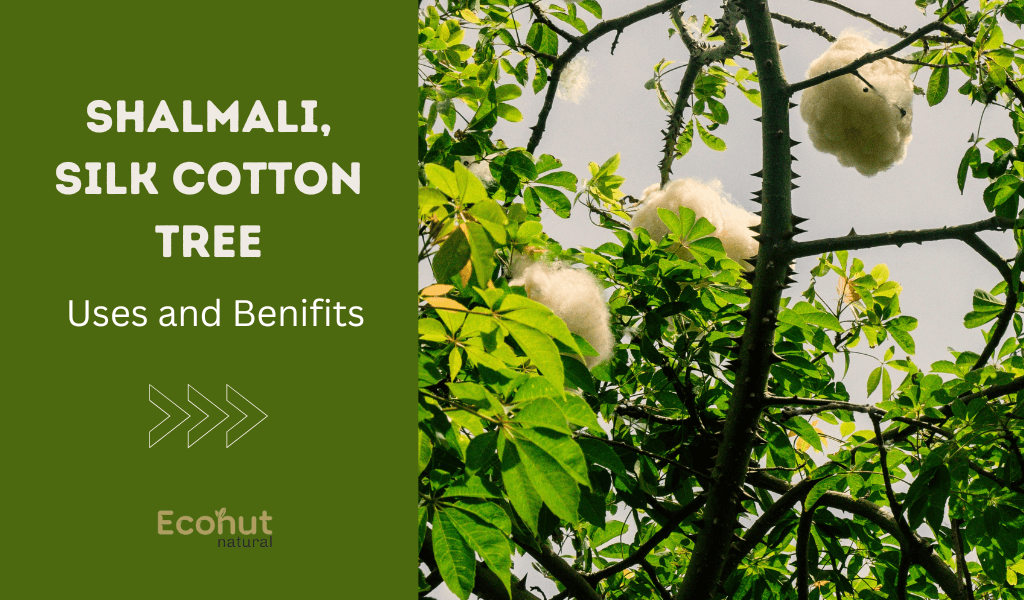Shalmali, scientifically known as Salmalia malabarica, is a species of tree native to the Indian subcontinent. It belongs to the family Malvaceae. Shalmali is also referred to as Kantakadya, Picchila, Mocha, Moharasa, Raktapushpa, and Sthirayu. Shalmali is native to India and Burma. Sanmali is an Ayurvedic herb that is loaded with health benefits.
The most health benefits of Shalmali have made it one of the prominent herbs in the Ayurvedic system. All parts of the tree including flower, gum, stem bark, petiole, peduncle, and thorns are used in Ayurveda due to its therapeutic properties.
Scientific Classification of the Shalmali, Silk Cotton Tree (Salmalia malabarica)
| Scientific name | Bombax ceiba |
| Family | Malvaceae |
| Genus | Bombax |
| Kingdom | Plantae |
| Order | Malvales |
Shalmali, Silk Cotton Tree (Salmalia malabarica) Uses
There are several uses uses of Shalmali, Silk Cotton Tree. We duscuss some of below.
Ornamental:
Silk cotton trees are often cultivated for their ornamental value. Their large, spreading canopies and attractive flowers make them popular choices for landscaping in tropical and subtropical regions.
Ecological Benefits:
Silk cotton trees provide shade, habitat, and food for various wildlife, including birds, insects, and mammals. They also help stabilize soil, prevent erosion, and contribute to the overall biodiversity of their ecosystems.
Fiber:
The most significant use of the silk cotton tree is for its fibers, which are obtained from the seed pods. These fibers, often referred to as kapok, are lightweight, buoyant, and water-resistant. They have been traditionally used as stuffing for pillows, mattresses, upholstery, and life jackets.
Medicinal:
Various parts of the silk cotton tree have been used in traditional medicine. For example, the bark is believed to have properties that can treat dysentery and other gastrointestinal issues. The leaves and seeds have also been used for their medicinal properties in different cultures.
Timber:
While not as common due to the softness of the wood, the timber of the silk cotton tree is sometimes used for light construction, such as making canoes, rafts, or temporary shelters. It’s not as durable as other hardwoods but can be utilized in specific contexts.
Cultural Significance:
In many cultures where silk cotton trees grow, they hold cultural and religious significance. They may be considered sacred or have mythological associations.
Environmental Uses:
Kapok fibers from the silk cotton tree have been explored for their potential use in environmentally friendly products, such as biodegradable packaging materials and insulation.
Also More: Limestone: Uses, Benefits, and Side Effects
Health benefits of Shalmali or Silk Cotton
Various parts of the tree, including the bark, leaves, flowers, and seeds, have been used in traditional medicine systems like Ayurveda for their therapeutic properties. Some potential health benefits of Shalmali are below.
Gastrointestinal Health:
In traditional medicine, Shalmali seeds are sometimes used to address gastrointestinal issues like diarrhea and dysentery. The seeds are believed to have astringent properties that can help to control loose stools and promote digestive health.
Skin Care:
Shalmali extracts are sometimes used in skincare preparations due to their reported astringent and anti-inflammatory properties. They may help to soothe irritated skin, reduce inflammation, and promote overall skin health.
Fever Reduction:
In traditional medicine, Shalmali leaves are sometimes used to help reduce fever. The leaves are believed to possess cooling properties that can help lower body temperature during febrile conditions.
Wound Healing:
Shalmali extracts are sometimes applied topically to wounds to promote healing. The astringent properties of the plant may help to staunch bleeding and promote the formation of healthy tissue.
Antioxidant Activity:
Certain parts of the Shalmali tree, including the leaves and flowers, contain antioxidants that can help neutralize harmful free radicals in the body. This antioxidant activity may contribute to overall health and well-being by protecting cells from oxidative damage.
Respiratory Health:
Shalmali flowers are often used in traditional remedies for respiratory conditions such as coughs, colds, and asthma. They are believed to possess expectorant properties, helping to relieve congestion and facilitate easier breathing.
Anti-inflammatory Properties:
The bark of the Shalmali tree is known to contain compounds with anti-inflammatory properties. This makes it potentially useful in reducing inflammation associated with various conditions such as arthritis and other inflammatory disorders.
Conclusion
Silk Cotton, or Shalmali, offers potential health benefits rooted in traditional medicine, including respiratory support, anti-inflammatory properties, and gastrointestinal relief. Its antioxidant compounds may aid in skin health and fever reduction, while its astringent nature could assist in wound healing. However, scientific evidence supporting these claims remains limited, necessitating caution and consultation with healthcare professionals before use.
FAQS
What are the health benefits of Silk Cotton?
Silk Cotton, or Shalmali, is traditionally used for respiratory support, anti-inflammatory effects, gastrointestinal relief, skin health, fever reduction, and wound healing.
How is Silk Cotton used for health purposes?
Different parts of the Silk Cotton tree, including the flowers, bark, leaves, and seeds, are utilized in various traditional remedies, such as herbal teas, extracts, poultices, and topical applications.
Is Silk Cotton safe to use?
While Silk Cotton has been used for centuries in traditional medicine, scientific evidence supporting its safety and efficacy is limited. It’s important to consult with a healthcare professional before using Silk Cotton or any herbal remedy, especially if you have underlying health conditions or are taking medications.
Can Silk Cotton help with respiratory problems?
Some traditional remedies involving Silk Cotton suggest it may help with respiratory conditions like coughs, colds, asthma, and congestion due to its expectorant properties. However, more research is needed to confirm its effectiveness.
Are there any side effects associated with Silk Cotton use?
Side effects of Silk Cotton use are not well-documented, but allergic reactions or adverse effects may occur, particularly in sensitive individuals. It’s crucial to use Silk Cotton cautiously and discontinue use if any negative reactions develop.
Can Silk Cotton be used for skin care?
Silk Cotton extracts are sometimes used in skincare products due to their reported anti-inflammatory and astringent properties. These extracts may help soothe irritated skin and promote overall skin health, but more research is needed to validate these claims.
Is Silk Cotton effective for wound healing?
Some traditional remedies suggest Silk Cotton may aid in wound healing due to its astringent properties. However, scientific evidence supporting its efficacy in this regard is limited, and further research is necessary to confirm its benefits for wound care.

